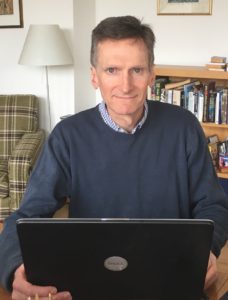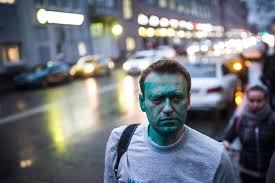10 September 2020
Alexei Navalny
Folk hero.
By Neil Tidmarsh
 Surely Alexei Navalny represents some sort of archetype? He and his brave fight against powerful and secretive dark forces could have come straight out of a folk tale. And a very Russian folk tale at that, as the work of the eminent Soviet folklorist Vladimir Propp could tell us.
Surely Alexei Navalny represents some sort of archetype? He and his brave fight against powerful and secretive dark forces could have come straight out of a folk tale. And a very Russian folk tale at that, as the work of the eminent Soviet folklorist Vladimir Propp could tell us.
Vladimir Yakovlevich Propp (1895-1970) chaired the Department of Folklore and was a faculty member of the Department of Russian Literature at Leningrad University. In his most influential work, Morphology of the Folk Tale, he analysed one hundred Russian folk tales to identify thirty-one basic structural elements – narrative ‘functions’ – and claimed that each and every Russian ‘wonder story’ or ‘fairy story’ consists of any number of these units, always occurring in the same linear order.
The work was published in Russia in 1928. It was translated and published in the West some decades later and it’s had an enormous influence in Western academic circles ever since, establishing an approach which has encouraged other scholars to look for similar structures in other human constructs such as films, adverts, novels, tv soap operas, games, etc. But if Propp were alive today, no doubt he would be gratified to see that his theories hold for a real-life Russian. Navalny’s blameless causes (democracy, political freedom, the rule of law, an end to corruption), his popularity (the authorities wouldn’t be so desperate to exclude him from elections if they didn’t think he’d win) and his enemies’ blatantly evil tactics (including violent attacks and underhand obstructionism) more than justify the title ‘folk hero’, but Propp’s work nails it for him. It’s possible to take almost any event in the career of this anti-corruption activist and opposition politician and identify it with one of Propp’s ‘functions’. For instance, to take ten of them almost at random:
11 June 2012; the authorities undertake a twelve hour search of Navalny’s home and office (and the home of a relative) following his arrest for taking part in anti-Putin protests. Propp’s Function number 4; Reconnaissance – the baddies make an effort to attain knowledge about the hero and his strengths and methods.
27 February 2015; opposition politician Boris Nemtsov is shot dead. Nemtsov had been working to create a wide coalition of opposition forces including Navalny’s Progress Party. Function number 8; Villainy – the baddies harm or murder a member of the hero’s family or community.
27 April 2017; Navalny is attacked outside the office of his Anti-Corruption Foundation. His assailants throw a solution of zelyonika (‘bright green’ – a triarylmethane anti-septic dye) into his face, which temporarily stains his face and permanently damages the vision in one eye. Function 17; Branding – the hero is marked in some way, perhaps receiving a distinctive scar or disfiguration.
Presidential elections 2018, Moscow Duma elections 2019; the authorities ban unsanctioned protests. Function 2; Interdiction – a command is issued, forbidding the hero from doing something or warning him off a particular course of action.
January 2018; Navalny leads protests calling for a boycott of the presidential elections. He is arrested. May 2018; he is arrested again, following further protests. He’s sentenced to 20 days and 30 days in prison. July 2019; Navalny is arrested yet again, following protests about the exclusion of independent candidates from the Moscow Duma elections. While in prison, he’s hospitalised with a mysterious ailment which severely damages his eyes and skin. Function 3; Violation of Interdiction – the hero refuses to obey the command and is punished.
In 2012/2013, Navalny is charged with embezzlement and found guilty; but an independent report on the case concludes that the legal system had been misused to silence political opponents, and in 2016 the European Court of Human rights rules that his right to a fair trial had been violated and orders the government to pay legal costs and damages. In 2013, as Navalny is trying to establish a new political party The People’s Alliance in the face of apparently insurmountable official obstructionism, an established party changes its own name to The People’s Alliance; however, few are fooled by this attempt to muddy the waters. In recent elections, a considerable number of candidates from the governing party re-brand themselves as ‘independents’ or ‘liberals’; however, this tactic is widely recognised as a smoke screen, a herd of stalking horses, an attempt to pull the rug from under the feet of true independents and liberals supported by Navalny. Function 24; Unfounded Claims – a false hero (one of the baddies or in league with the baddies) attempts to deceive by making unfounded claims. Function 28: Exposure – the false hero is exposed, and the claims shown to be unfounded.
In 2005, his youth movement “DA! – Democratic Alternative” organises political debates to be televised by the state-run Moscow channel TV Center, but the show is suddenly cancelled after only two episodes. Navalny subsequently turns to new information technology (the internet, drones, video) and harnesses social media (twitter, facebook) to broadcast his anti-corruption research and his opposition activism. His work reaches a massive audience. Function 14; Receipt of a Magical Agent – the hero finds and masters a new and mysterious item – a tool or weapon or item of clothing or food – which enables him to further his task.
August 2020; Navalny is taken ill on a flight from Tomsk to Moscow. He goes into a coma. The plane makes an emergency landing in Omsk, where he is taken to hospital and put on a ventilator. His colleagues suspect poison, but the authorities say that the hospital has found no sign of it. Function 21; Pursuit – the hero is pursued by his adversaries who attempt to capture or destroy him.
August/September 2020; a plane is sent from Germany to evacuate Navalny for treatment in a Berlin hospital. The Omsk hospital eventually releases him. German doctors confirm that he has indeed been poisoned. The German government announces that the poison was a Novichok nerve agent, a chemical weapon widely believed to be available only to agents of the Russian state. On September 07, the doctors treating him say that he has been brought out of the coma and now “responds when he is spoken to”. Function 22; Rescue – the hero is saved.
So what happens now? If we reverse-engineer Propp’s analysis and attempt to complete the story by synthesising some of the remaining functions, we could expect the following – the hero returns (function 20) transfigured in some way (function 29), the villain is defeated (function 30) and the victorious hero finally marries the princess / ascends the throne / is elected president (function 31).
Here, of course, caution and common sense remind us that real life is not a fairy tale and that a happy ending is never guaranteed outside the story books. Nevertheless, all this also reminds us that folk tales and fairy stories aren’t mere frivolous and vacuous fantasies but reflect the profound hopes and fears of an entire community (perhaps even of the whole of mankind) and are acutely aware of the forces which shape society for good or ill. And as for a happy ever after, well, who knows? We certainly hope for the best as the doctors continue to do what they can in Berlin and as the world outside Russia prepares its reaction to this latest atrocity.


